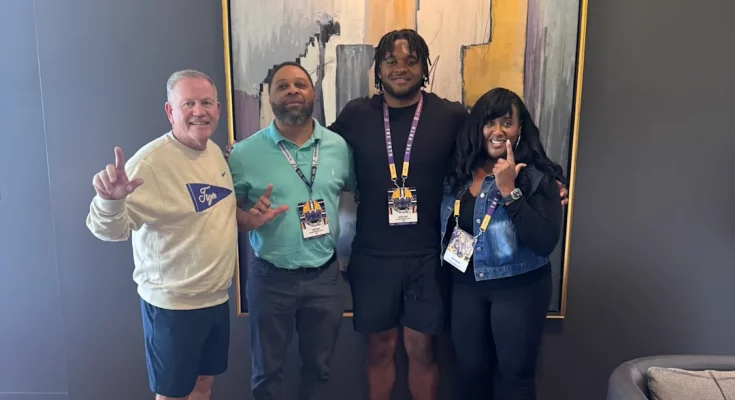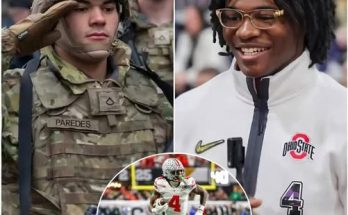The recruitment of offensive linemen in college football has always been one of the most decisive battles in shaping the future of a program, and when it comes to LSU football, few stories capture the attention of fans and analysts quite like the pursuit of the nation’s No. 1 interior offensive line prospect. This five-star recruit has already cemented himself as one of the most coveted talents in the 2025 recruiting class, drawing offers and attention from virtually every powerhouse program in the country. But what makes his story even more intriguing is the fact that LSU is not only in the thick of the race for his commitment, but one of their own top-ranked commits is reportedly pushing hard to bring him into the Tigers’ family. For LSU fans, this is the kind of storyline that blends star power, program trajectory, and the ever-growing influence of peer-to-peer recruiting.
When evaluating an interior offensive lineman of this caliber, scouts and coaches immediately point to traits that set him apart from thousands of prospects across the country. Standing well over 6-foot-4 and weighing close to 320 pounds, he has the rare combination of size, balance, and athleticism that makes him a plug-and-play star at the college level. He isn’t just a big body who wins matchups with brute force; he is a polished technician who excels in hand placement, footwork, and the ability to maintain leverage in both pass protection and run blocking. These traits make him the type of player who doesn’t just project as a starter down the road, but someone who could potentially compete for immediate playing time at a program like LSU, where the trenches are always a critical part of championship contention. His dominance on film is evident—he swallows up defenders, moves seamlessly to the second level, and opens gaping holes for his running backs. In short, he is the type of lineman who can change an offense from the inside out.
For LSU, the recruitment of a player like this represents more than just adding talent—it is about reinforcing the program’s identity. LSU has long prided itself on being a powerhouse in the trenches, producing NFL linemen at a consistent rate while maintaining a physical identity in the SEC. After years of fluctuation in offensive line play, Brian Kelly and his staff have emphasized recruiting elite linemen to restore dominance up front. Landing the No. 1 interior lineman in the country would not only solidify their 2025 recruiting class but would also send a message across the SEC that LSU’s offensive front is poised to return to championship form. The Tigers have already built momentum with several high-profile commits, and this particular target would serve as the crown jewel of the class.
What makes this recruitment especially compelling is the role that peer recruiting has begun to play. In modern college football, coaches certainly drive the pitch, but recruits themselves often serve as some of the most influential voices. The elite LSU commit who has reportedly taken it upon himself to push for the lineman’s pledge embodies this trend. Already locked in with the Tigers, this commit understands the value of surrounding himself with the best talent possible. By making personal connections, building friendships, and reinforcing the vision of LSU’s future, he is doing work that even the most persuasive recruiter on staff might struggle to accomplish. When a peer tells a five-star prospect, “Come join me, and let’s build something great together,” it carries a sense of authenticity and shared purpose that resonates. It shows that the players themselves believe in the program and its trajectory, which can often be more powerful than any pitch a coach could deliver.
For the five-star lineman, this type of push only adds weight to an already difficult decision. With offers from programs like Alabama, Georgia, Ohio State, and Texas, he is spoiled for choice when it comes to selecting his future home. Each of these schools can offer him elite facilities, exposure to the NFL, and a chance to play for national championships. But what LSU has working in its favor is both its strong tradition and the momentum it currently carries under Brian Kelly. Since arriving in Baton Rouge, Kelly has made it clear that he intends to build LSU into a model of consistency that can rival Alabama and Georgia year in and year out. The Tigers’ ability to combine top-notch skill talent with a retooled and dominant offensive line is central to that vision, and few recruits embody that goal more perfectly than the one in question.
The presence of an elite peer recruit pushing him toward LSU also points to something deeper—culture. In today’s game, players are increasingly focused not just on winning but also on finding a program where they feel they belong, where they can be part of a brotherhood that extends beyond the field. When they see other top recruits not only choosing LSU but actively recruiting them to join, it creates a sense of unity that is hard to replicate elsewhere. It is no longer just about a coach’s promises but about a collective effort from players who want to build something together. This is the type of culture that turns a good recruiting class into a great one, and a great one into a championship-winning roster.
Of course, the five-star lineman’s decision won’t come overnight. Recruiting battles of this magnitude often stretch deep into the calendar year, with official visits, in-home meetings, and media speculation fueling the drama. LSU fans know the story well; the Tigers have been in many of these races before, winning some and losing others. The difference this time, however, may very well be the internal pressure applied by a fellow five-star who is already part of the Tigers’ future. The recruit’s pitch isn’t just about glitz and glamour—it’s about building a foundation together. That authenticity can prove decisive when a player is weighing programs that, on the surface, may seem equal in resources and prestige.
From a strategic standpoint, landing this lineman could also have a ripple effect on LSU’s overall recruiting momentum. When one five-star commits, others often follow, seeing the program as a legitimate contender to field a super-class. Momentum in recruiting is real, and programs that manage to stack elite commitments in short order often end up with top-ranked classes. LSU is already in position to close strong in 2025, but adding the nation’s No. 1 interior offensive lineman could catapult them into the national top five. It would also reassure fans and boosters that the staff’s emphasis on the trenches is paying off.
The larger story here is the evolving landscape of college football recruiting itself. It is no longer simply about coaches battling over recruits with promises of development and championships. It is about relationships, player-led efforts, and a sense of shared purpose that stretches beyond the locker room. The five-star lineman represents the highest level of talent available, but the dynamic being created by his LSU peer recruiter represents the new age of how commitments are won. Programs that understand this shift and empower their commits to serve as ambassadors will continue to thrive, and LSU seems to be at the forefront of that movement.
At the end of the day, this recruitment will be remembered not just for the player himself but for the way it symbolizes LSU’s strategy under Brian Kelly. The Tigers are chasing elite players with a relentless focus, and they are doing so by creating an environment where recruits want to recruit others. Whether or not the nation’s No. 1 interior offensive lineman ultimately dons the purple and gold remains to be seen, but one thing is certain—LSU is all in, and the presence of a committed five-star working behind the scenes might just be the edge they need. For Tiger fans, it’s a storyline worth watching closely, because if this recruitment goes their way, it could reshape the future of LSU’s offensive line and solidify the program’s standing among the SEC’s elite for years to come.



